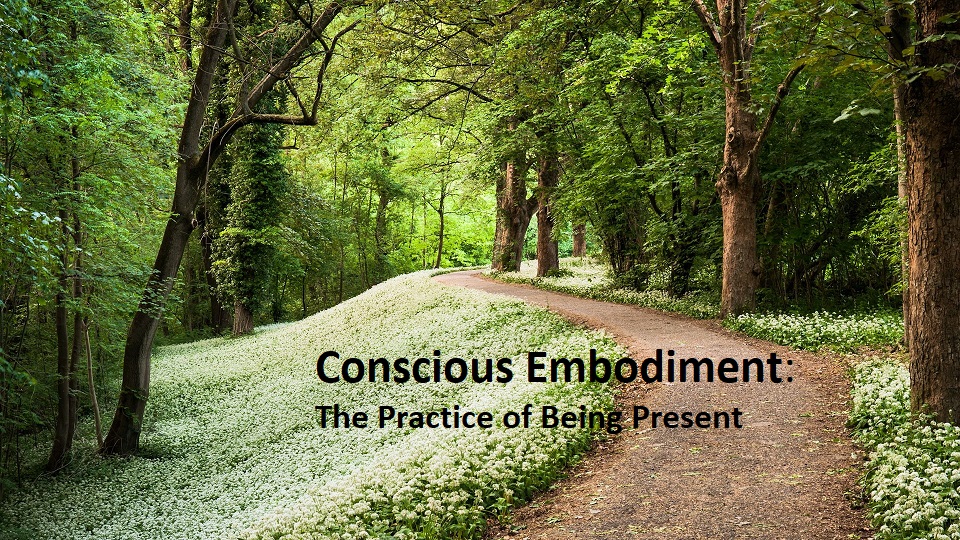
Practising Presence in
Everyday Life

It is very challenging on a day-to-day basis to remain aware that I am not my thoughts, I am not my feelings, I am not my history and I am not my story. The experience of this human life is so captivating – in all senses of the word. Captivating in the sense of wonderful experiences; captivating in the sense of holding our focus; captivating in the sense of holding us hostage. We are held hostage by the sensory information registered in our bodies and by our thoughts. We are held captive by the meanings we put to things and to events, to the unfolding stories that we ourselves are creating.
As Michael Singer describes in The Untethered Soul this is like getting so engrossed in a movie that we forget there is an "I", a consciousness that is actually sitting there watching the movie. Practising presence is about sustaining your awareness of the "I", the Self that is conscious of having this experience of this human life.
This is why I call this blog "Conscious Embodiment". It is about practising presence as a way to cultivate your awareness of the experience you're having, yes, but ultimately, your awareness of the consciousness that is you, that is aware of having this experience.
Now, I'm not talking here of an intellectual awareness of the idea of a consciousness that is aware of having this experience. What I am talking about is this awareness as a "felt sense" that becomes a part of the conscious experience you are having, and of becoming a growing "percentage" of that experience.
What do I mean by that?
Practising presence (which includes, but is not limited to, mindfulness) allows you to be more aware of your thoughts and your feelings. Now, you might say, "what do you mean, more aware? I am very aware of my feelings and thoughts." But to the degree that you are consumed by your feelings, or disturbed by them, or that you feel in some way helplessly affected by them, then you are not so much aware of the experience as engrossed in it.
If I hit my finger with a hammer, I will be feeling the pain and all my awareness is caught up in reacting to the pain. Without practising presence, I don't have a detached awareness of myself having all these reactions to the pain, an awareness that is grounded in a solid sense of constancy, a sense that there isn't really any major problem. Instead, I am mostly caught up in feeling pain, in not wanting to feel pain, in being upset with myself for having caused myself pain, and in thinking about what I need to do to stop the pain. This is like being totally caught up in the movie or TV show, identifying totally with the character(s) and forgetting that you are just you, sitting on the couch, watching it.
Practising presence cultivates an awareness of my own presence, my own consciousness, my own self, that is unhurt in this experience, that is unchanged by it, that is always intact and pure and healthy.
The more you practice presence – and, especially, practising it in all sorts of ways, in daily life – the more you cultivate this awareness. And by awareness, again, I am not talking about an awareness of a concept. I'm talking about an experiential awareness, a felt sense.
So, it begins with things like mindfulness meditation, and mindfulness practice in the activities of daily living such as cooking, cleaning, walking, reading. Practising presence is not just something to do at focused times, like meditation. It is a practice that can be practised in all areas of everyday life, in the most mundane of daily tasks.
For instance, brushing your teeth. When you are brushing your teeth, where is your attention, where is your awareness? Are you trying to move around and get things done while you brush your teeth, treating the activity of brushing your teeth as necessary, but an impediment to doing the stuff you really need to do? Do you spend your time thinking about other things? Practising presence would mean simply bringing your full attention to the present moment in which you are brushing your teeth. This, in and of itself, is mindfulness. But beyond the simple mindful awareness, practising presence would mean intentionally being aware of your physical presence within your body. Engaged in the movements, the sensations.
You can practise presence while driving. While there is nothing wrong with listening to music when you're driving or having a conversation, try now and then just practising presence. Being present to yourself in the present moment, and fully present to your surroundings. Not in the sense of being "watchful". That is the experience of being a separate, individual observer/actor. Being present to your surroundings really means being present within your surroundings. Being present to yourself does not mean being engaged in thinking; it means being present within yourself. Aware of your internal experience including thoughts and feelings, but centred in a still place that is not engaged in the thoughts or feelings.
Practising presence can also be done in the sense of attending to things that need to be attended to, in the sense of not avoiding or delaying. For example, as you move through your living space, you might pass an item that needs to be put away. Every time you pass that item you may or may not notice it. You may think to yourself, "the next time I pass here I should…" Simply attending to that, here and now, acting on and with that awareness allows you to flow with the present, and with your awareness of the present (which includes both your awareness of your environment and of your own thought.)
Simply being present rather than distracted with your mind and focused elsewhere, increases the probability that you will notice what needs doing. Practising presence would then also mean once you notice it, you deal with it (obviously, not if you are pressed for time or in a rush.) This brings us to an important point. If you tends to be in a rush and pressed for time, then that is a state of not being fully present, is a condition that arises from not practising presence, and it is something that can be remedied by practising presence. (See my blog about "Rushing" to read more about that!) But you must be willing to slow down. Ultimately, to be in the present moment, to be in the "now" and to practice presence, means choosing to slow down.
